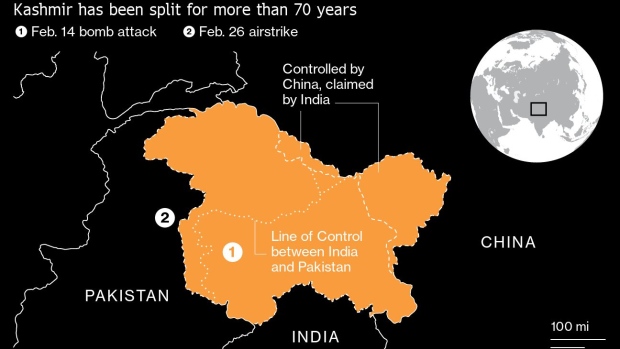May 21, 2020
South Asian Rivals Prepare for Bloody Summer in Disputed Kashmir
, Bloomberg News

(Bloomberg) -- When Prime Minister Narendra Modi took control of the disputed Kashmir region last August, he said it would bring India’s only Muslim-majority state closer to the rest of the country and improve economic conditions.
That was echoed by his powerful Home Minister Amit Shah: “Terrorism in Kashmir will end and it will progress on the path of development,” he said after lawmakers ended nearly seven decades of autonomy in Jammu and Kashmir state, which is also claimed by Pakistan.
Yet nine months on, all signs point in the opposite direction. As snows melt in the Pir Panjal Ranges, opening up mountain passes used by militants from Pakistan to cross over to India-controlled Kashmir, security chiefs are predicting a bloody summer in the crisis-torn valley, where 12.5 million residents are still locked down.
In the first four months of this year alone, cross-border shelling by the two armies across the Line of Control -- the 740 kilometer (460 mile) disputed border between India and Pakistan -- averaged around a dozen incidents each day, said several senior officials from India’s security establishment who asked not to be named, citing rules for speaking with the media.
By mid-April there’d been more incidents than the total number recorded last year and nearly as many as the annual total for 2018. Infiltration attempts from Pakistan into India have risen four times in April in comparison to same period last year, the officials said.
India and Pakistan have fought three major wars since independence, two of them over Kashmir. A terrorist attack on an Indian police convoy in Kashmir in February 2019 and the ensuing military clash brought the nuclear-armed rivals close to the brink again.
This intensified violence is a response to India’s revocation of Kashmir’s special status, said Ian Hall, professor in the school of government and international relations at Griffith University in Queensland, Australia, and author of the 2019 book “Modi and the Reinvention of Indian Foreign Policy.”
“Islamabad was bound to respond by relaxing some of the controls it had imposed on the military in the area and on some of its alleged terrorist proxies, and that is exactly what it has done,” Hall said via email on Wednesday. “India was bound to react to the shelling and infiltrations with greater force. The two sides are, to an extent, trapped into this cycle.”
Heavy Artillery
Both India and the U.S. see Pakistan as providing safe haven for terrorist groups and note the leadership of groups such as Jaish-e-Mohammed and Lashkar-e-Taiba, which carried out the Mumbai attacks in 2008, still live freely in Pakistan.
As many as 10 Indian soldiers, including a commanding officer of a counter-terror unit, were killed in just two counter-terror operations this month. One of the “most-wanted” commander of the Hizbul Mujahedeen -- a militant group that operates in Kashmir and whose leaders are based out of Pakistan -- was killed along with another suspected terrorist in a separate encounter.
Both sides have used heavy artillery and howitzers instead of small arms. India’s Army Chief Manoj Mukund Naravane visited the state soon after. A few days later, Pakistan Army Chief Qamar Javed Bajwa visited Pakistan-controlled Kashmir.
Pakistan said since the beginning of the year, India was responsible for 1,101 incidents of cease fire violations in which civilians were also killed. “The situation at the LOC has become very serious in view of the Indian Army’s behavior and statements of Indian leadership,” Pakistan Army spokesperson Babar Iftikhar said via phone from Islamabad.
This week, Islamabad summoned a senior Indian diplomat to protest against the cross-border firing for a second time since January.
“India will gain nothing by ratcheting up tensions with Pakistan, as shifting focus to Kashmir when Indian abuses are at their worse cannot be a good strategy,” Abdul Basit, Pakistan’s former high commissioner to India, said in a message. “Since the world has been largely insouciant, and now stuck with Covid 19, India is taking full advantage to obliterate the freedom movement.”
Recruitment Rises
Other parameters also look grim. Since March, even before the mountain passes became accessible, the Indian security establishment was alarmed at the steady stream of intelligence that pointed to several groups of militants gathering. As many as 68 militants have been killed by security forces, which is nearly half the number killed in 2019.
The data on recruitment of Kashmir locals by militant groups also shows the suppression of militancy that followed the revocation of Jammu and Kashmir’s special status was a temporary phenomena. Only 25 militants were killed from August till December last year.
“It is hard to see the violence across the Line of Control diminishing without some kind of diplomatic circuit breaker, or -- worse -- some misstep that leads to something worse,” Hall said. “In Kashmir, it depends on how draconian New Delhi is willing to be -- and it has shown itself quite willing since August 2019.”
©2020 Bloomberg L.P.